If you’re an aspiring artist or simply someone who eats, sleeps, and breathes music, you might have wondered how to start a music blog.
There’s plenty of evidence to suggest that now is a fantastic time to get into the music blogging game.
In the first half of 2021, US recorded music revenues grew an impressive 27% year on year to more than $7 billion, according to the Recording Industry Association of America.

Research from the International Federation of the Phonographic Industry reveals that people are listening to more music than ever before, with the average person tuning in for 18.4 hours a week — up from 18 hours in 2019.
In part, this upturn in listening time appears to be linked to the pandemic, with eight in 10 music fans saying that music helped their emotional wellbeing as the world lurched in and out of lockdown.

And while we constantly see headlines that suggest streaming is destroying the music industry, we actually spend comparatively little on streaming compared to our various other music-related expenditures.
Indeed, Nielsen discovered that the average person spends $156 on music, of which streaming makes up just 9% of the total.
In short, if you’ve been thinking about becoming a music blogger, now’s the time to take the plunge. In this article, we’re going to show you how to do it.
Why Start a Music Blog?
Being a massive music fan or an up-and-coming act isn’t enough reason to start a music blog.
Fact is, running a successful music blog requires a significant investment in time.
It takes an average of 4+ hours to write a single blog post, and that’s before you factor in building your own website, developing your personal brand, and using tactics like search engine optimization and social media marketing to grow your traffic.
Here are four reasons why it’s worth all the effort:
Share Your Work
Starting a music blog gives you a ready-made portfolio for your work.
That “work” could be new music you’ve created. It could be content that demonstrates your knowledge and writing skills, positioning you for a role in the music press.
Or it could be about uncovering the hottest new acts in your area, setting you up for a career in the music industry.
Expand Your Resume
In a similar vein, having your own blog can be a fantastic way to underscore your music industry credentials.
Every artist needs a personal brand, and starting a music blog can help you build one.
Not only that, but having a successful music blog can unlock new opportunities that wouldn’t otherwise have been available. Maybe it’ll land you an internship at one of your favorite record labels or get you a booking at one of your favorite music festivals.
Build a Community
Community is super important in the music world. Your “community” could include:
- Fans who listen to your music or read your articles
- Local artists who are open to collaborating
- Publications and journalists who support your work
- Promoters who want to book you for gigs
- Club events or festivals in your area
…and lots more besides. Your music blog can be the hub for your newfound community, giving you a central space to tell people what you’re working on next, where you’re appearing, which artists you love, and what plans you have for the future.
Make Money!
Music fans might be quick to criticize artists for “selling out”, but the fact is, everyone’s got to eat. So while making money might not be your primary motivation to start a music blog, it should definitely be a consideration.
Your music blogging project gives you lots of potential avenues for monetization. We’ll talk about those avenues in more depth later on in this article, but broadly speaking, they include:
- Advertising
- Affiliate marketing
- Selling your own products
Examples of Successful Music Blogs
The first step on your music blogging journey is to see how other music bloggers are doing it. Here are three of our favorite music blogs:
Pitchfork
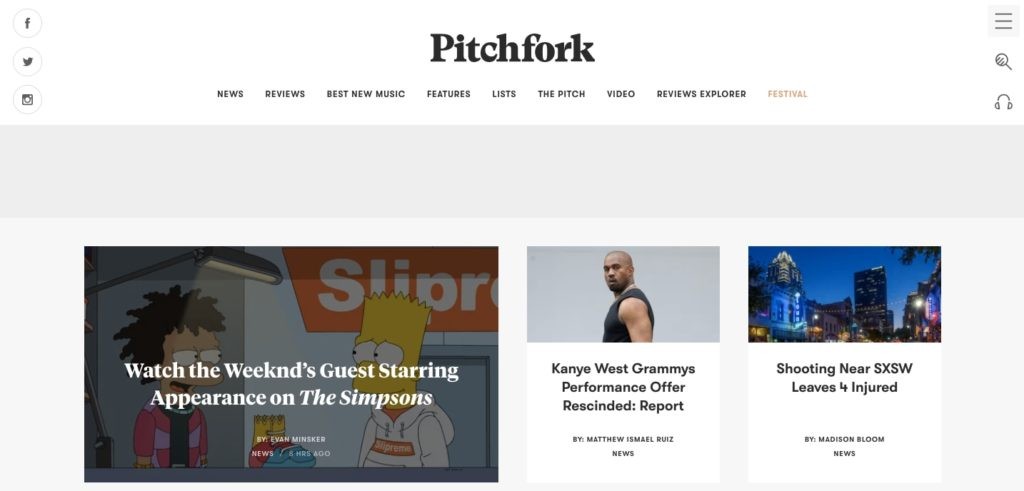
Love it or hate it, Pitchfork is one of the most successful music blogs out there. Predominantly a new music blog, it publishes tons of music reviews, features, and interviews, as well as covering all the biggest news from the music world.
It makes money through advertising and affiliate marketing…
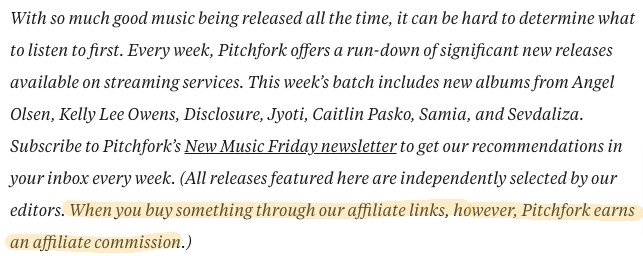
…as well as organizing its own music festivals in Berlin, Chicago, London, and Paris.
BrooklynVegan
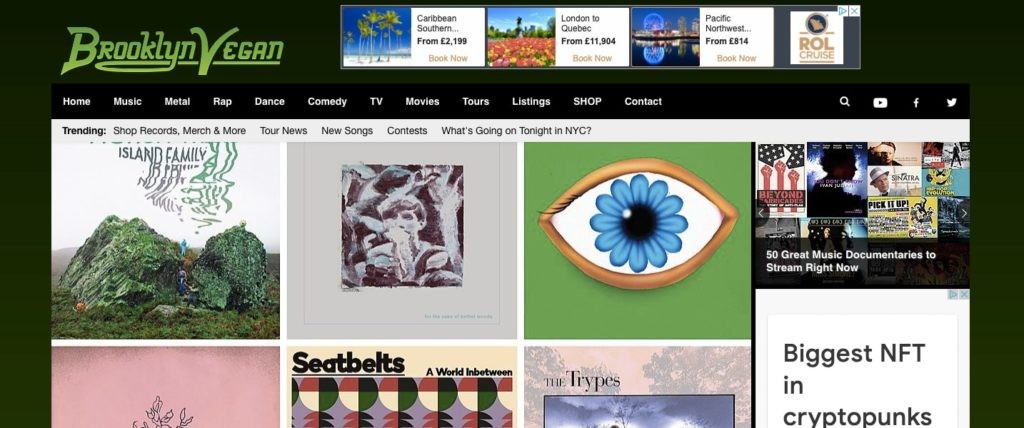
As the name suggests, BrooklynVegan is a New York City-focused music blog that writes about new songs, live show reviews, tour dates, gossip, music industry news, and more.
Founded back in 2004, it’s expanded over the years, in part by acquiring the long-running metal blog Invisible Oranges in 2013. It predominantly makes money through advertising.
ReverbNation

ReverbNation is a social networking platform that aims to help musicians, music venues, and promoters to communicate and collaborate. It also helps artists reach millions of fans via some of the world’s biggest music sites.
As such, its blog isn’t about promoting third-party products; it’s all about marketing the ReverbNation platform. Content focuses on marketing and promotion, touring and gigs, music management, and the process of creating music.
How To Start a Music Blog in 10 Steps
Okay, we’ve got the theory out the way, so now we’re going to talk through the process of how to start a music blog.
1 Narrow Down Your Music Niche
In reality, the music niche isn’t much of a niche at all. It’s just too big.
If you launch a generalist music blog, you’re not going to appeal to anyone.
Why? Because people value expertise when it comes to music. If you’re looking for recommendations on new hip-hop artists, you’d go to a hip-hop music blog, not one that also writes about everything from vaporwave to 10th-century Gregorian chants.
So your first task is to hone in on a much more specific blogging niche — ideally one in which you can add real value. At the very least, it should be something you’re truly interested in; music fans can spot a faker a mile off!
It pays to consider your target audience at this step. Who are you trying to reach? And why would they visit a site like yours?
Clearly, there are any number of potential target audiences within the overarching music niche. Examples include:
- People who want to learn how to play a musical instrument
- People searching for music recommendations or reviews in a specific genre
- People looking for gig listings and concert tickets in their local area
- People who want advice on how to start a band or record music
- People looking to buy merchandise for their favorite act
- People searching for information about a specific artist
- People aiming to find a local music venue or club night
- People searching for free music resources
Of course, there are tons of other examples too. As you can no doubt imagine, all of those different audiences will be looking for very different content.
So while you don’t need to 100% nail down your chosen blogging niche at this stage, you should definitely have a shortlist of potential options.
Struggling for inspiration? Don’t worry. At Authority Hacker, we’ve got tons of experience in creating content websites across a vast range of industries, so we know a thing or two about choosing a niche.
For starters, websites like Detailed and FeedSpot can help you find examples of other music blogs. Read through a bunch of those blogs, figure out the primary niche each one of them is targeting, and decide which (if any) of those niches is most appealing to you.
Failing that, turn to one of our favorite search engine optimization platforms, Ahrefs. One of its many features is a handy tool called Competing Domains that lets you enter a “seed” website — such as BrooklynVegan — and search for other music blogs targeting similar keywords:

Again, take your time to scroll through that list of domains and pick out sites you like the look of. You might even want to run some of them through Competing Domains too, giving you a wider list of music blogs to examine.
Take note of the blogging niche each website is targeting and use that information to inspire your own choice.
2 Choose a Blogging Platform
You’ve chosen a niche — congrats! Now it’s time to start the process of building your music blog. And the first step in that process is to choose a blogging platform.
Simply put, a blogging platform gives music bloggers the tools to publish and manage the content they create.
Some blogging platforms enable users to choose a unique domain name, select a web host, and build a site from scratch, whereas others — like HubPages and Medium — keep bloggers within a standard platform environment.
Moreover, some are free, while others charge for their services.
Early in your music blogging project, it can be tempted to go with the cheapest option. More to the point, you might even be questioning why you need to start a music blog at all. Wouldn’t it be faster and cheaper to start a podcast or create a bunch of YouTube videos?
Let’s deal with that final point first. While it’s certainly possible to make money in the music industry without a website, we wouldn’t recommend it.
When you go the social media route, you’re reliant on a single platform to reach your target audience. If your chosen platform chooses to tweak its algorithm (which happens all the time), you might suddenly find yourself losing a bunch of traffic.
But if you start a music blog, you can leverage a whole bunch of channels to generate blog traffic, engage your audience, and make money.
You can leverage search engine optimization to target relevant keywords. You can build an email newsletter and use it to share your latest content. You can create multiple social profiles, each with the goal of sending traffic to your blog. You can even run ads to bring paid traffic to your site.
So starting your own website is the smart option. And when it comes to creating a blog, we recommend WordPress.org over all the other blogging platforms.
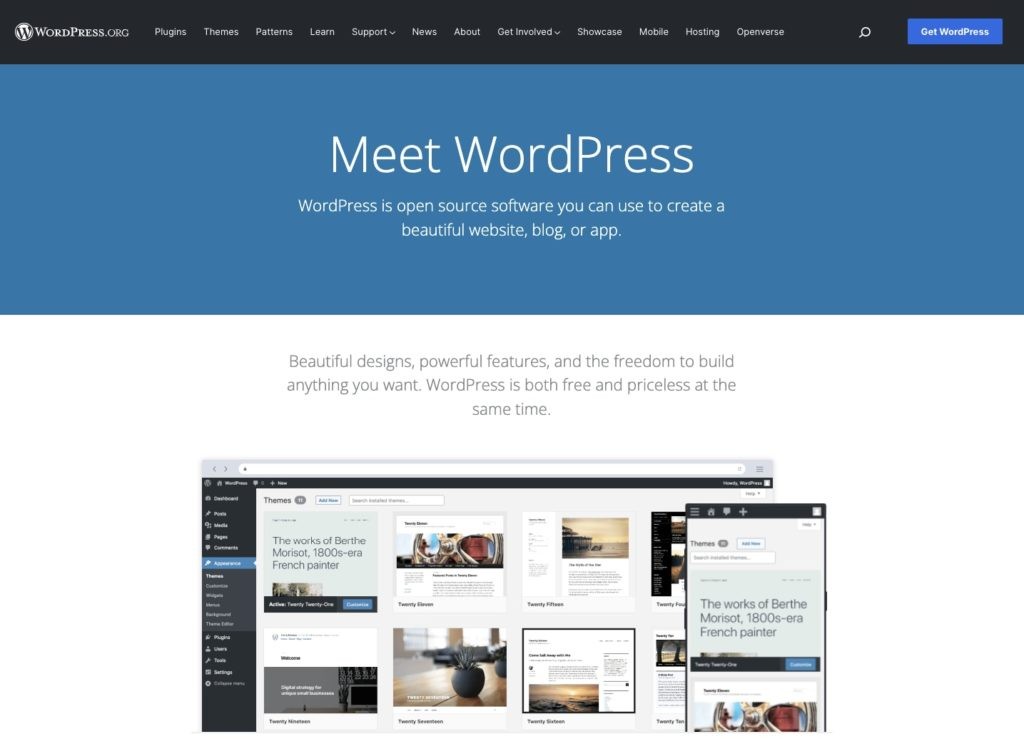
It’s not the cheapest option, because you’ll need to choose a domain name and hosting provider. But there are lots of positives to building a self-hosted WordPress blog, such as:
- Getting started is quick and relatively cheap
- It gives you complete freedom over monetization
- There are lots of ways to customize your website…
- …but you don’t need any coding experience to use it
- You retain ownership of all the content you publish
- It gives you access to thousands of WordPress plugins to expand your music blog’s functionality
Also, because you’re building a music blog, you’ll definitely need the ability to add audio and video files to your site. WordPress allows this, too.
3 Choose a Domain Name
The next step is to bag yourself a domain name.
Now, one small downside to having a self-hosted WordPress blog is that you won’t get a free domain name (or, at least, not a permanently free domain). But don’t let that put you off, because it won’t cost you the earth: you’re looking at $9 – $14.99 for a full year.
Of course, cost isn’t the only factor here.
Far more important is deciding on a domain name — something that reflects your personal brand, stands out on a busy search engine results page, and is memorable enough to keep blog visitors coming back time and time again.
That’s a lot of things to achieve, and not many characters in which to achieve them. So no pressure!
Still, choosing your music blog’s name needn’t be a stressful experience. Just follow these best practices:
Select a .com domain name
There are lots of whacky new domain extensions out there. You might be tempted to choose a music-themed extension like .audio or .band, but be warned: 70% of people say they don’t trust these “newer” domains.
So nine times out of 10, the smart choice is to go for a .com extension.
Keep it short and snappy
Cast your eyes back 1,000 words or so and take another look at those other music blogs. One thing they all have in common is a short domain name — one or two words.
Simply put, shorter domains are easier to remember, so keep your blog name to a maximum of three words.
Align your domain name with your niche
It might sound obvious, but your domain name should speak to your chosen blogging niche. Sure, you want to be clever.
But if you’re starting a music blog about concerts in Los Angeles, laconcertlistings.com is a better name than lostinthenight.com.
Make smart use of synonyms
There are a whole lot of other music bloggers out there, so you need to accept that your first choice of domain name might not be available.
Synonyms can be your best friend here: if laconcertlistings.com has already been snapped up, go with lagiglistings.com instead.
Don’t niche down too far
Sure, finding a niche is important, but you don’t want your choice of domain name to limit the topics you can cover on your music blog. Better to go with laconcertlistings.com than westhollywoodconcertlistings.com.
One final point on this: don’t get too hung up on your domain name.
Sure, it’s important, but don’t let it become a barrier that stops you moving on with starting a music blog. Set aside a chunk of time — say, an afternoon — to brainstorm potential domain names, then pick your favorite and head on to step four.
4 Buy Your Domain & Hosting
So far, all the actions required to start a music blog have been creative in nature. But at this point, things are going to get a little bit technical. Don’t sweat it, though, because we’re here to hold your hand through the whole process!
Because you’ve chosen the self-hosted WordPress approach, your music blog simply won’t exist until you’ve bought a domain and chosen a hosting provider.
Again, there are plenty of options when it comes to web hosting, but we recommend Siteground. It has good hosting support, it’s easy to use, and offers decent performance.
Now, let’s talk through the seven simple steps to buying a domain and hosting through Siteground…
Step 1: Navigate to Siteground’s WordPress hosting page.
Step 2: Pick your preferred hosting plan. Options range in price from $3.99 – $10.69 per month, but the cheapest plan offers everything you need to get started, and it’s free to install WordPress.
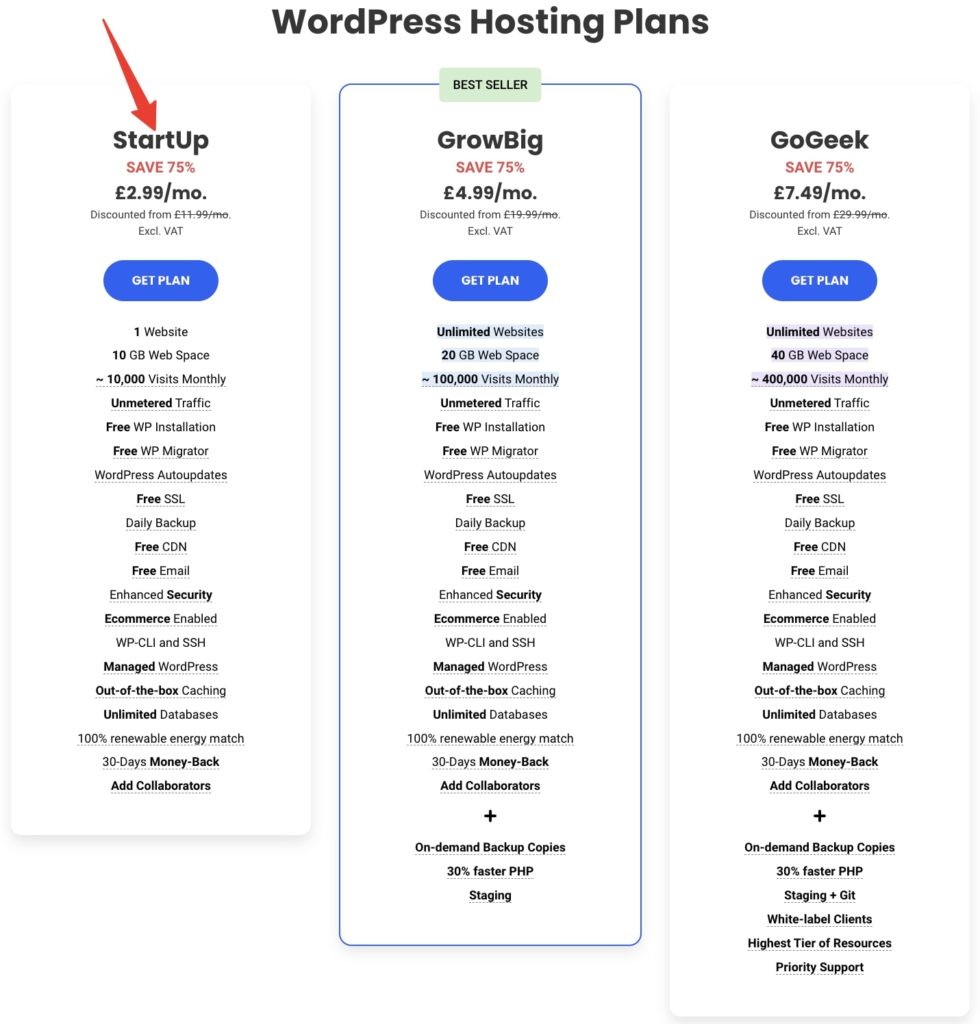
Step 3: Once you’ve picked your preferred plan, enter your domain name. This is self-explanatory: if you’ve already registered a domain, click I already have a domain. If not, hit Register a New Domain.
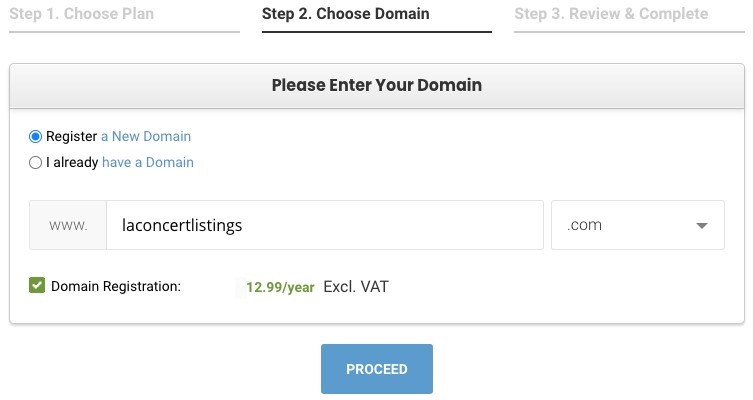
Step 4: At this point, Siteground will ask you for a bunch of information on your account, location, and payment details. Again, this is all easy stuff.

Step 5: Choose your package length. Siteground offers contracts ranging from one month to three years, but at time of writing, the best deal is on the 12-month plan, so we’d recommend choosing it.
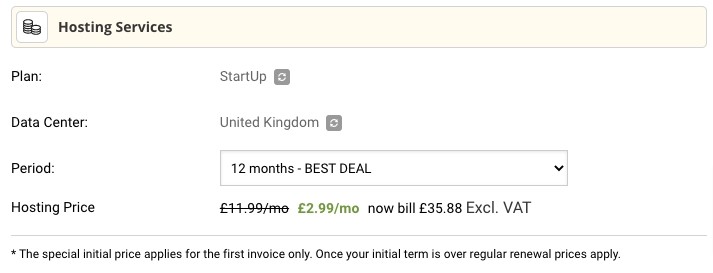
Step 6: Pick out any extra services you need. Unless you’ve already registered your domain, you’ll need to select Domain Registration. As for the other options, you don’t need them, but you might want them anyway (after all, they’re pretty cheap).

Step 7: Pay the bill, sit back, and admire your brand new piece of online real estate!
5 Choose a Theme
One of our favorite things about WordPress.org is the wealth of WordPress themes available. Those themes allow you to breathe some personality into your music blog.
Simply put, a WordPress theme dictates the look of your website. You want a theme that speaks to your blogging niche and resonates with your audience.
For instance, a blog about music management might have a more corporate, professional feel, while an electronic dance music concert listings-themed music blog should be less formal and more fun.
There are tons of free themes available, and while premium (i.e. paid) WordPress themes offer greater scope for customization.
There’s really no harm in starting with a free WordPress theme and upgrading to the premium version down the line when you need the additional functionality.
Use platforms like Astra and Kadence to find the right WordPress theme template for your music website.
Installing a WordPress theme is simple; just follow these short steps:
- Log in to WordPress
- Click Appearances in the left-hand dashboard menu
- Navigate to Themes
- Select Add New at the top of the page
- Choose a theme that fits your style and audience
- Click Download to start the installation process
- Once the installation is complete, hit Activate
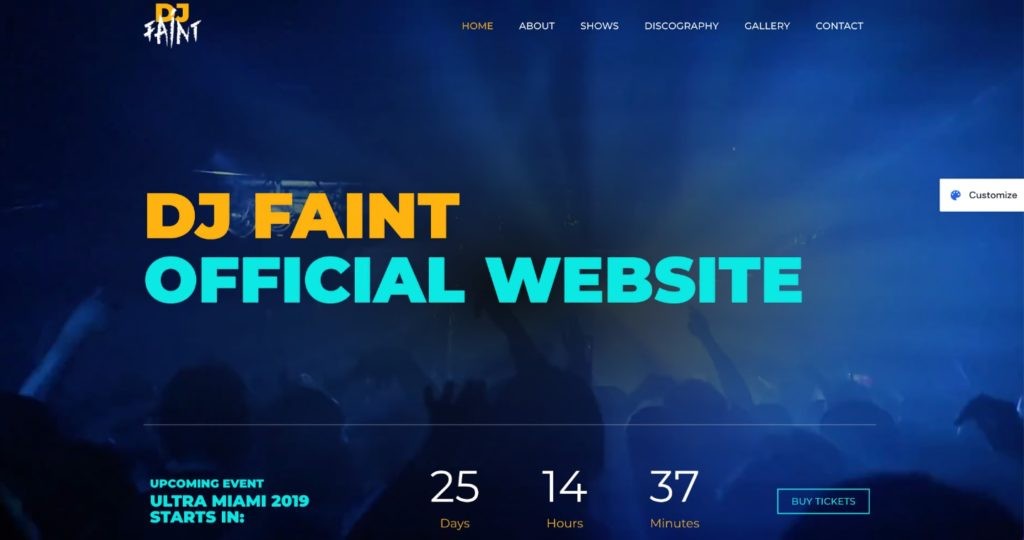
At this point, it’s important to note that not all WordPress themes are equal. You might find two great-looking themes, but their actual suitability might be vastly different. With that in mind, might sure your chosen WordPress theme ticks the following boxes:
- It should be fast
- It should have excellent reviews
- It should be responsive (i.e. optimized for a range of devices)
- It should offer great customer service in case you encounter and problems
- It should be easily customizable
6 Choose Your Design & Branding
You might think choosing a WordPress theme is the end of the design process. But you’d be wrong.
Let’s be honest — you likely won’t be the only music blog out there using your chosen theme, so if you just stick with the out-of-the-box version, you’ll struggle to stand out from all those other music bloggers.
There are two pieces to this particular puzzle: your color palette and your logo.
We’ll start with the first piece. You might want to choose a complementary palette of colors, tones, and shades that naturally blend in with one another. Or you might want something that clashes to give your music blog an edgier feel.
Either way, Coolors can help you find the perfect palette. With its color palette generator, you can just keep hitting the spacebar until you find a combination that appeals to you.
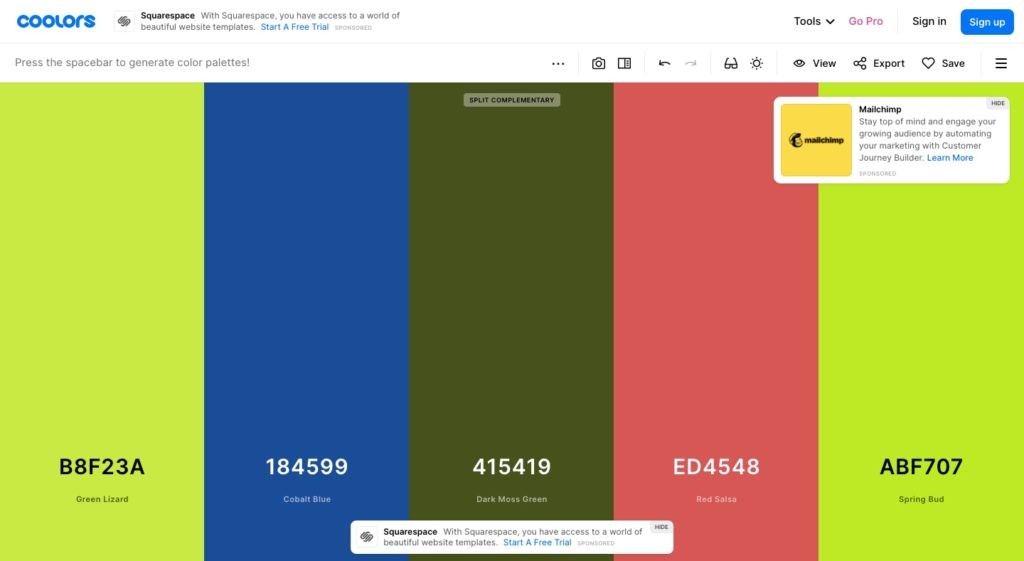
Next, let’s talk logos. Your logo will be front and center of your music blog, and will also appear across your various social media accounts (and any other channels you choose to promote your site). So it’s kind of important.
Unless you’re an experienced graphic designer, this step can feel pretty intimidating. You might have a beautiful, stylish vision for how your logo can look, but when you try to make it a reality, it ends up looking like a first-grade art project.
But it doesn’t need to be like that. There are plenty of fantastic (and free) graphic design resources out there to help you create an amazing logo. We’d recommend starting with Canva, which offers a bunch of readymade music logo templates:
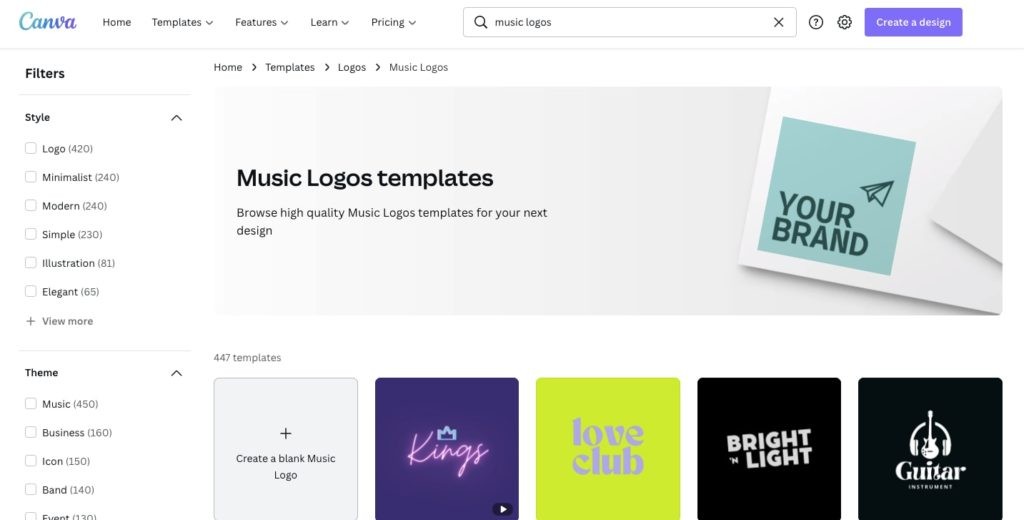
Add your name to an existing template, or use the examples to create your own from scratch.
7 Create Essential Pages
After all those steps, your music blog is really starting to take shape. You’ve picked out a domain name, chosen an eye-catching theme, and added some personal branding touches.
Now it’s time to start populating your bare-bones website with the following essential pages:
Homepage
For most blogging sites, the homepage will be the first port of call for the majority of visitors. So it needs to explain what your music blog is about, and it needs to look good, while making it easy for people to click deeper into the site.
Don’t worry; the technical part of building those pages couldn’t be easier:
- Log in to your WordPress dashboard
- Navigate to Pages
- Click Create New Page
About Us
If people wanted to read totally dry, impartial information about the music industry, they’d go to Wikipedia.
Your blog visitors want to hear about you — why you love folk music, country music, or electronic music; how you learned to identify trends in the music industry; when you first stepped into a recording studio.
The About Us page is your opportunity to spell out all that important stuff.
Contact Page
There are any number of reasons why people might want to reach out to you.
Club events might want to book your band; record labels might want to sign you; fellow music bloggers might want to collaborate on guest posts; readers might just want to praise the way you critique music!
Either way, make it easy for them by including links to your social media channels and adding a contact form to your contact page.
Privacy Policy
Your privacy policy page spells out the way you gather data from blog visitors (and what you do with it). If you’re not sure where to start, services like PrivacyPolicies.com can do it for you.
8 Start Creating Content
Now your music blog has started to take shape, it’s finally time to create content!
Chances are you’ve already got a million and one ideas for your first blog post. But cool your jets, because before you start typing away furiously, it pays to do a spot of keyword research.
According to Ahrefs, a frankly ridiculous 90.6% of pages on the internet get absolutely no traffic from Google, while a further 5.3% bring in 10 or fewer visitors per month.
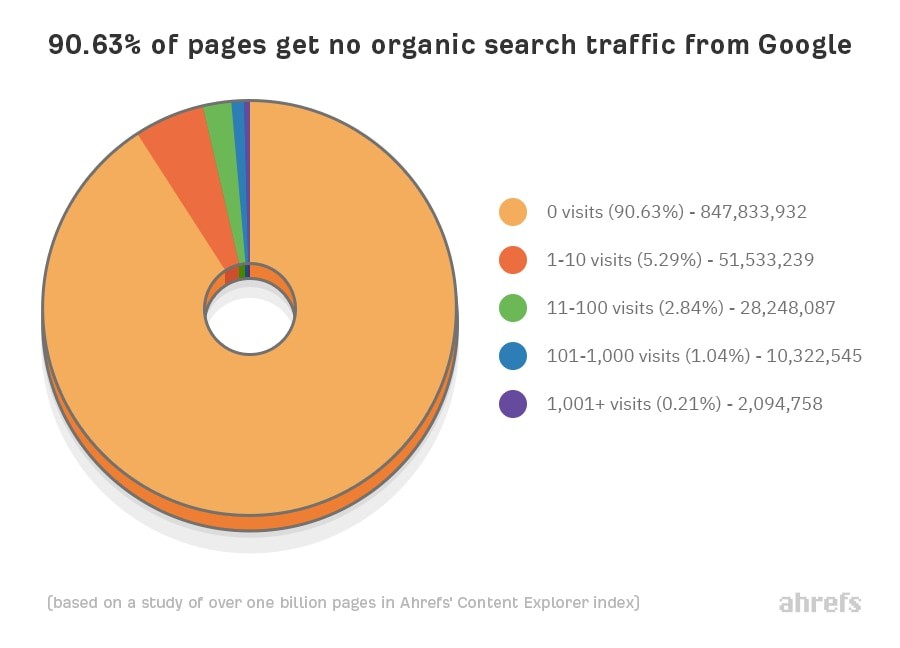
With a lot of those pages, the problem started way before they were published: the creator simply neglected to identify any target keywords. In other words, they never stood a chance of attracting search traffic.
Of course, even if you do spend a bunch of time on keyword research, there are no guarantees. There are a whole lot of music bloggers out there, not to mention a bunch of other sites that have a more-than-passing interest in the music niche.
That’s why you should be looking for highly specific, less-competitive keywords to target. But volume is important too; there’s no point spending four hours writing a post if the keyword you’re targeting only generates 10 searches a month.
Fortunately, Ahrefs can help. We use the Keywords Explorer tool to add a “seed keyword” and use it to find a bunch of matching terms. For instance, here’s a list of matching terms for the seed keyword “free music”:
| Keyword | Monthly search volume |
|---|---|
| how to make a slideshow with music and pictures for free | 3100 |
| how to download music for free | 2400 |
| how to get free apple music | 1900 |
| how to download music to your phone for free | 1800 |
| how to download free music | 1400 |
| where to download free music | 1200 |
| what apps let you listen to music offline for free | 1000 |
| how to download free music on iphone | 1000 |
| how to download music from youtube to computer free no software | 800 |
| how to download music on iphone for free | 700 |
| how to cancel apple music free trial | 600 |
| how to download free music on android | 600 |
| how to download music from spotify for free | 600 |
| how to get free music on an iphone | 600 |
| what is the best site to download free music? | 600 |
| what is royalty free music | 600 |
While a lot of those terms are pretty damn competitive, any one of them could make for an excellent title. And once you’ve picked out your titles, you can start the writing process — just be sure to follow these best practices:
Set a clear focus for each post. It’s easy to veer off-topic, so keep yourself on track by planning the stuff you want to discuss before you start writing. Put yourself into the shoes of your blog visitors: what information are they looking for? What takeaways do you want them to leave with?
Take advantage of internal linking. This feeds in nicely to the previous point. When you set a specific focus for each blog, you’ll naturally find areas of overlap. For instance, a post on how to get free music on an iPhone might cross over with one on how to get Apple Music free. Rather than repeating yourself, add internal links in those posts so readers can find more information. As an added bonus, internal linking is great for SEO.
Keep your audience front of mind. While you’ve got an overarching target audience, you might also have several sub-audiences. For instance, a music blog writing about guitar tuition might target complete beginners, intermediate guitarists, and advanced players looking to hone their skills. Those sub-audiences will be looking for very different information, so figure out who each post is for before you start writing.
Make it personal. Again, remember: this is a blog, not an encyclopedia, so don’t be afraid to add some personal stories. Maybe you’ll talk about a music store that gave you amazing service or how you discovered a certain piece of new music. Either way, that personal touch can bring your content to life.
Ask questions to your readers. Your blog is nothing without a loyal audience, so build engagement by asking them questions. Do they agree with your latest article? Do they have their own recommendations or advice? Consider adding a comments section to your music blog so it’s easy for readers to carry on the conversation.
Add emotion to your content. Music is a passionate subject because it’s so subjective. We might hear the same piece of music and feel completely differently about it. So don’t be shy about writing with emotion. If you love (or hate) something, tell people!
9 Promote Your Blog
Given all the time and research that goes into the process of creating fantastic content, the last thing you want is for no one to ever see your posts. That’s why you need to get your amplification strategy right.
“Amplification” is about how you promote your music blogs. Unless you’ve got the budget to pay for Google or social media ads, there are three main ways to bring in blog traffic:
Encourage Blog Visitors to Sign Up For Your Newsletter
Wouldn’t it be great if you had a readymade list of people queuing up to read your latest content?
When you build an email list, that’s exactly what happens. Ask blog visitors to hand over their email addresses, then every time you create content, you can send it straight to them.
Pitchfork uses this tactic to grow its email list, incorporating email capture forms on its homepage and within each blog post it publishes.

Use Search Engine Optimization
Hopefully, you’re already planning to target specific keywords in your music blogs. But that’s only scratching the surface of SEO.
The fact is, there are lots of ways you can optimize your music blog to generate more search traffic — far more than we can go into here.
Share Music Blog Posts On Social Media Channels
Chances are, you’ll have multiple social media accounts. You might have an Instagram, a YouTube channel, a Facebook page, a Twitter profile, a TikTok account — and maybe more. Each of those channels gives you an opportunity to get more eyes on your content through social media marketing.
Here, we can see how BrooklynVegan uses Instagram to compel followers to read its latest blog post by clicking the link in its bio:
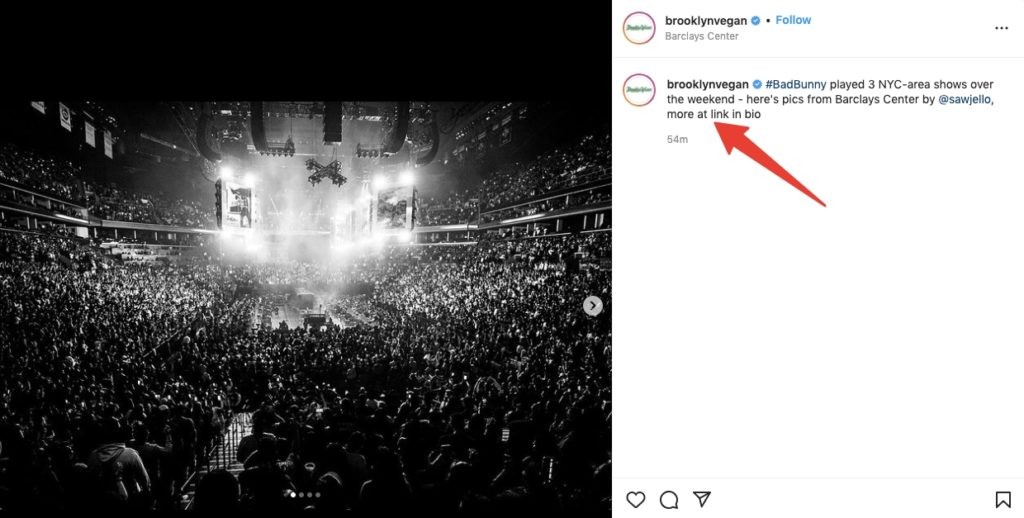
10 Monetize Your Blog
As you can see, it takes a bunch of time (and a little money) to start a music blog.
So it’s not unreasonable to think about how your new music blog can start paying for itself — and ideally turn a profit.
There are three main ways to make money as a music blogger:
1. Affiliate Marketing
In our opinion, affiliate marketing is the simplest and most reliable way to monetize a music blog.
You’ll naturally be recommending products and services anyway — whether that’s a streaming platform, a physical music release, a specific musical instrument, or something else.
So it makes sense to add affiliate links to your content, so that when your music blog visitors click through and make a purchase, you earn a commission.
Like the sound of affiliate marketing? Check out our guide on how to start affiliate marketing and our list of the best music affiliate programs in 2024.
2. Advertising
Selling ad space is another easy way to make money as a music blogger.
One option is to join an ad network, like Raptive or Mediavine. Those networks display adverts to people who visit your music blog — and whenever those people click an ad, you’ll receive a small fee in exchange.
Another route is to search for sponsors. The earning potential is higher, but it takes a lot more work on your part, because you’ll need to reach out to brands yourself and ask if they want to sponsor your music blog.
Not only that, but you’ll need to find a way to process payments, and offer some kind of reporting and analytics. Realistically, this approach is only likely to work if you’ve already built an established audience.
3. Sell Products
Finally, some music blogs make money by selling their own products.
Assuming you don’t have the time or inclination to build your own physical products, there are two avenues available here:
- Sell digital products. For a music blogger, there are lots of potential options to create and sell digital products. For instance, you could offer online music tutorials, or package your best articles into an ebook and sell it as a downloadable asset.
- Offer services. If you know the music business like the back of your hand, you might be able to sell your expertise as some kind of consultative service. For instance, maybe you’ll offer coaching and advice to new music acts trying to attract record labels.
Conclusion
As you can see, there are no easy answers to the question of how to start a music blog.
It takes a lot of hard work just to get your new music blog up and running, let alone getting it to a position where it attracts consistently high traffic volumes and makes money.
But the rewards are worth it. After all, so many music fans dream of a life spent writing about their favorite bands or sharing content about their latest projects.
And the good news is, we can definitely help you along the way.
We’ve built a lot of websites over the years, and we’ve learned a thing or two along the way. We’d love to share the seven secrets that make new blogs 83% more successful — all you need to do is sign up for our free training.
See you there!








